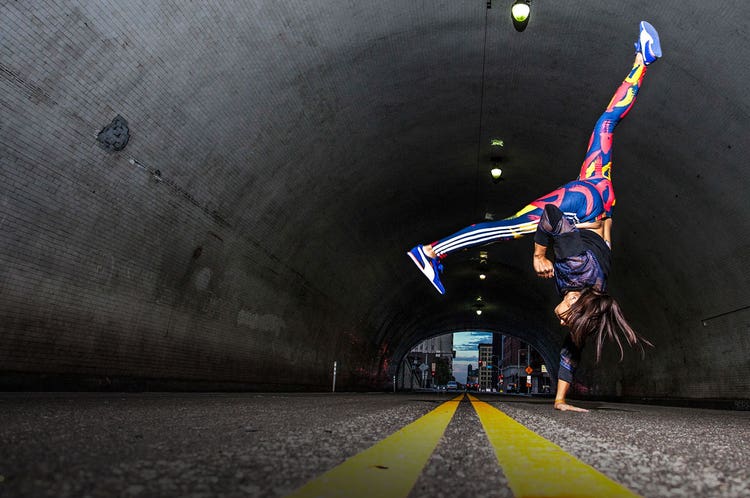The First Functional Fitness

Running up walls. Leaping from rooftop to rooftop. Careening over and under the industrial urban landscape. That’s what most of us think of when we hear of — or Google — parkour: a “sport” for acrobatic athletes who don’t seem to possess a fear of heights, falling or injury. According to dictionary.com, the origin of the word parkour comes from the French “parcours” (course) which comes from an even earlier Latin compound meaning “run through.” Indeed, parkour involves moving from one point to another and trying to get past or through any obstacles in the quickest and most efficient way possible.
Dan Edwardes says that the principle underpinning the discipline is that its movements are precisely those the human body has evolved to do — namely, to move over, around and through our environment. He is founder and managing director of Parkour Generations, the world’s leading professional organization for this dynamic movement discipline, and creator of the largest and most successful parkour teaching framework in the world.
Parkour Generations teaches parkour to children, adults and seniors around the world. Edwardes explains, “We are looking to help people restore the ability to do it well. Through doing it, people come to understand this creates a fit, healthy, long-lasting body because that’s how we’re built. It’s absolutely for everyone.”
BASIC HUMAN MOVEMENT
The all-inclusiveness flies in the face of what most people believe about parkour. By introducing — or reintroducing — participants to the fundamental categories of movement, non-athletes and athletes start at whatever point their conditioning allows. Initially, parkour training focuses on our earliest movement patterns: rolling and crawling.
As an infant, “You roll, before you crawl — it’s the first way any human gets anywhere,” Edwardes points out. “Rolling is a useful way to disperse movement and energy when you land. And rolling and falling skills are key, because once you learn you can do them without getting hurt, you can and will try a lot more.”
The aim is to restore our basic ability to get over something in our path, to jump, land, crawl and run through space in a way that’s healthy — supporting our bodyweight and minimizing impact. Parkour instruction focuses on movement skill sets. The first set, called low gait or quadripedal movement, includes not only rolling, but jumps and landing on a single foot or both feet, as well as drop jumps. Another major family of movement includes swinging, climbing and brachiation — in other words, our ability to pull our bodyweight up a surface using upper body strength, and being able to climb sideways or down, as well as swing and catch ourselves (as we did on the playground monkey bars).
Yet a third important set of skills is called passemore in French — the ability to pass an obstacle without breaking pace, whether that’s vaulting or hurdling, passing through or going under something, all the while supporting our bodyweight and maintaining balance in motion. This movement family develops — and requires — proprioception, or your sense of your own body in space. For elite parkour athletes, it means walking easily along railings and bars. Edwardes says that this work introduces a dimension of challenge that builds competence. And the more physically competent you become, the more confident you become.
FOCUS, NOT FEAR
In addition to following the natural progression of learned human movement, there’s another important reason for beginning with forms of movement that take place close to the ground (or on it). They help to eliminate the fear of falling. Edwardes says that when the body is free of fear, it can relax, and that makes us more mobile and more flexible — so that fear is no longer inhibiting our movement. He continues: “Once you’re warmed up, your range of motion, mobility and strength come into play and when you do similar movements standing or over obstacles, it becomes easier.”
And you’re willing to try more. What might appear to be a total lack of fear among its elite practitioners, is actually a reflection of the degree to which mindset is inextricable from movement in parkour. Edwardes says, “We don’t see the mental and physical as separate. If you deconstruct the movements to the point that mental focus is not required, you won’t build the degree of skill required to master them.”
He compares parkour practice to other sports that comprise complex, dynamic, non-linear movement — like tumbling, skateboarding and surfing. “The most important thing, from our perspective, is to get people to tap into graceful movement without too much thought. If I tell you I’m going to throw a Frisbee and want you to catch it, you’ll run as naturally and gracefully as you can — but if I explain and ask you to demonstrate the biomechanics of running, you won’t.”
Edwardes hopes more people will understand that parkour is a paradigm shift: an application of functional fitness that creates truly practical adaptation. Our built terrain is designed to have as few obstacles as possible, so our basic movement skills atrophy over time and we need to create new patterns. “We spend years building patterns that are not good for the body, that we need to rebalance or even undo.”
From Edwardes’ perspective, strength training and conventional functional fitness exercises break down movement to components that can be helpful for recovery or movement correction, but that don’t create the practical adaptations that parkour can. By way of illustration, he says, “you can’t feed yourself with a bicep curl” — a simple, linear movement that doesn’t replicate the complex, dynamic motion necessary to get a spoon to your mouth.
“The body is designed to move over terrain and if it’s not doing that, it’s not functional.” He adds, “People always tell me that after their first parkour class, they go home and notice what they could be climbing up and over.”
Watch the Parkour Generations team put those basic human movements into stunning action.